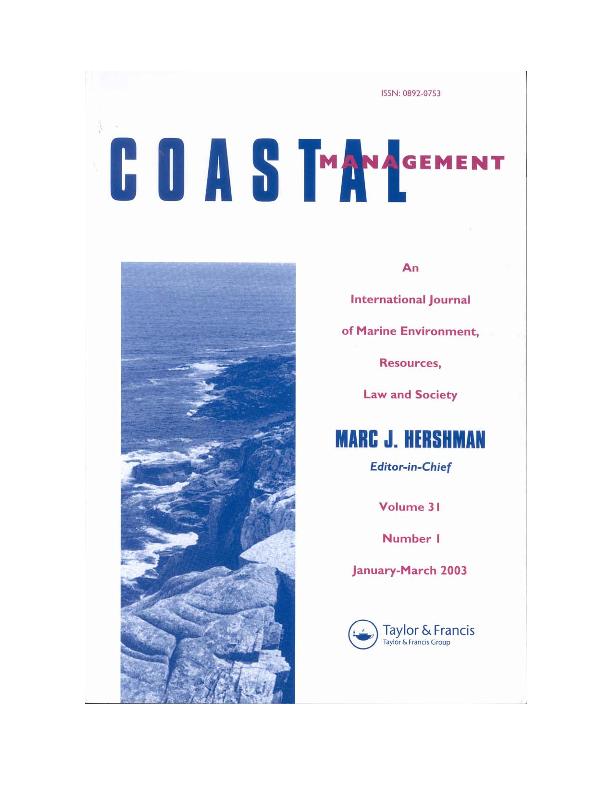Mostrar el registro sencillo del ítem
dc.contributor.author
Barragán Munoz, Juan M.
dc.contributor.author
Dadon, Jose Roberto

dc.contributor.author
Matteucci, Silvia Diana

dc.contributor.author
Morello, Jorge Helios

dc.contributor.author
Baxendale, Claudia Alicia

dc.contributor.author
Rodríguez, Andrea
dc.date.available
2021-07-23T19:44:44Z
dc.date.issued
2003-03
dc.identifier.citation
Barragán Munoz, Juan M.; Dadon, Jose Roberto; Matteucci, Silvia Diana; Morello, Jorge Helios; Baxendale, Claudia Alicia; et al.; Preliminary Basis for an Integrated Management Program for the Coastal Zone of Argentina; Taylor & Francis; Coastal Management; 31; 1; 3-2003; 55-77
dc.identifier.issn
0892-0753
dc.identifier.uri
http://hdl.handle.net/11336/136833
dc.description.abstract
The continental coastal zone of Argentina can be differentiated by environmental, biological, socioeconomic, and historical characteristics in four distinct regions. The Great Fluvial region, 3725 km long, shows richness of natural resources and has a developing economy based on forestry and agriculture, The La Plata River (Río de la Plata) region, with a 392 km waterfront, is the most densely populated, urbanized, industrialized area in the country, and it also exhibits high levels of environmental degradation. The Pampean (Pampeana) and the Patagonian (Patagónica) regions have a 4725 km litoral They hold important fishery stocks, the largest of which (the hake) is currently overexploited. Tourism demand has caused urban landscape to progress in the Pampa coast during the last three decades. In Patagonia, most of the natural resources are well preserved but the territorial and economic integration is still delayed. Despite the environmental and socioeconomic differences among the four regions, there is, however, a common set of problems which, to a greater or lesser extent, affect them all: (a) privatization of the public domain; (b) inadequate urban planning of the coastal zone; (c) industrial and urban pollution; (d) coastal erosion linked to inadequate coastal management practices; (e) overexploitation of natural resources; (f) loss and fragmentation of natural habitats leading to the loss of biodiversity; (g) increased coastal vulnerability. According to this diagnosis, coordinated specific, long-term actions should be promoted. Even when Argentina has a wide range of environmental legislation, it lacks a single tool or instrument specifically designed for coastal management. Most of the regulations and administrative requirements applied to the current coastal zone management are general normatives, and thus diffuse or hardly suitable for specific situations. We propose to attain consensus about a minimal preliminary basis in order to develop a national integrated management coastal program. Some of the issues are: design of specific governmental policies; creation of a specific institutional organization; long-term funding for the program; promotion of inter-institutional coordination and public participation in the decision-making process; development of specific research, education, training and information generation; and promotion of international cooperation aimed at sharing experiences in coastal zone management.
dc.format
application/pdf
dc.language.iso
eng
dc.publisher
Taylor & Francis

dc.rights
info:eu-repo/semantics/openAccess
dc.rights.uri
https://creativecommons.org/licenses/by-nc-sa/2.5/ar/
dc.subject
ARGENTINA
dc.subject
ICZM
dc.subject
LA PLATA RIVER BASIN
dc.subject
PAMPA
dc.subject
PATAGONIA
dc.subject.classification
Ecología

dc.subject.classification
Ciencias Biológicas

dc.subject.classification
CIENCIAS NATURALES Y EXACTAS

dc.title
Preliminary Basis for an Integrated Management Program for the Coastal Zone of Argentina
dc.type
info:eu-repo/semantics/article
dc.type
info:ar-repo/semantics/artículo
dc.type
info:eu-repo/semantics/publishedVersion
dc.date.updated
2021-07-23T14:38:28Z
dc.identifier.eissn
1521-0421
dc.journal.volume
31
dc.journal.number
1
dc.journal.pagination
55-77
dc.journal.pais
Reino Unido

dc.journal.ciudad
Londres
dc.description.fil
Fil: Barragán Munoz, Juan M.. Universidad de Cadiz. Centro Andaluz Superior de Estudios Marinos; España
dc.description.fil
Fil: Dadon, Jose Roberto. Consejo Nacional de Investigaciones Científicas y Técnicas; Argentina. Universidad de Buenos Aires. Facultad de Arquitectura y Urbanismo. Grupo de Ecología del Paisaje y Medio Ambiente; Argentina
dc.description.fil
Fil: Matteucci, Silvia Diana. Consejo Nacional de Investigaciones Científicas y Técnicas; Argentina. Universidad de Buenos Aires. Facultad de Arquitectura y Urbanismo. Grupo de Ecología del Paisaje y Medio Ambiente; Argentina
dc.description.fil
Fil: Morello, Jorge Helios. Consejo Nacional de Investigaciones Científicas y Técnicas; Argentina. Universidad de Buenos Aires. Facultad de Arquitectura y Urbanismo. Grupo de Ecología del Paisaje y Medio Ambiente; Argentina
dc.description.fil
Fil: Baxendale, Claudia Alicia. Universidad de Buenos Aires. Facultad de Arquitectura y Urbanismo. Grupo de Ecología del Paisaje y Medio Ambiente; Argentina
dc.description.fil
Fil: Rodríguez, Andrea. Universidad de Buenos Aires. Facultad de Arquitectura y Urbanismo. Grupo de Ecología del Paisaje y Medio Ambiente; Argentina
dc.journal.title
Coastal Management

dc.relation.alternativeid
info:eu-repo/semantics/altIdentifier/url/https://www.tandfonline.com/doi/abs/10.1080/08920750390168309
dc.relation.alternativeid
info:eu-repo/semantics/altIdentifier/doi/https://doi.org/10.1080/08920750390168309
Archivos asociados
